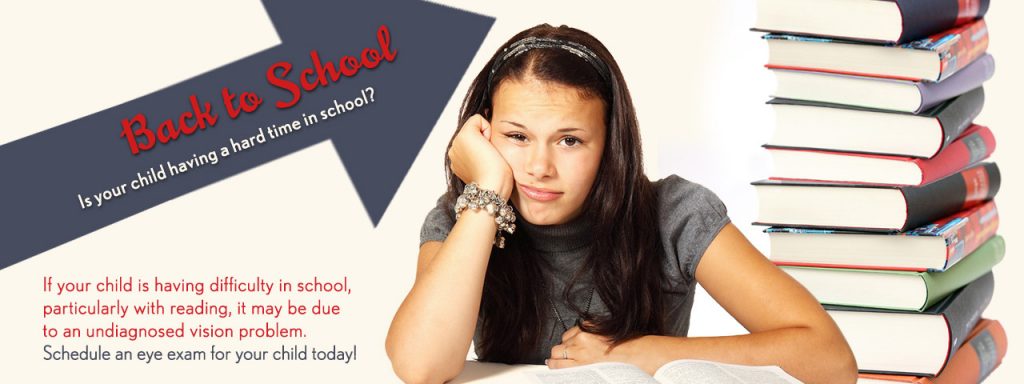Is your child struggling to keep up with their classmates? A vision condition may be affecting their ability to achieve academic success.
The following eye conditions can significantly impact reading and learning.
Amblyopia (lazy-eye)
Amblyopia, commonly known as “lazy eye” is a visual condition that affects up to 3 in 100 children in the United States.
Lazy eye occurs when one eye is unable to achieve normal visual acuity, and typically causes blurry vision in the affected eye (even with corrective lenses), poor depth perception, and reading difficulties.
A lazy eye can make reading quite difficult— causing loss of place, skipping words, re-reading words, misreading or substituting words, and adding words into sentences.
A child with a lazy eye must exert extra focusing effort to keep the words clear— leading to fatigue and reduced concentration while reading.
A lazy eye is generally difficult to recognize because it usually develops in only one eye, without a noticeable eye turn.
Although this condition cannot be corrected with eyeglasses or contact lenses, with early detection and vision therapy, children with amblyopia can achieve clear and comfortable binocular vision.
For many years, it was thought that a lazy eye was only amenable to treatment up to the age of seven or eight years. However, clinical research conducted by the National Eye Institute (NEI) has now proven that effective treatment outcomes can be seen in teenagers up to age 17.
Convergence insufficiency
Convergence insufficiency affects up to 17 percent of children and adults.
Convergence insufficiency (CI) is a common near vision condition that impacts the ability to read, learn, and work at near distances.
This condition occurs when the eyes are unable to work together, and instead, one eye tends to drift outward or away from the target when reading or performing other near vision activities.
Children with CI often experience blurry or double vision, eye strain, and headaches when reading, using a computer or performing other near vision activities for an extended period of time.
This condition tends to manifest or worsen as the demands in school increase for reading and homework assignments.
Convergence insufficiency often goes undetected in children, as it can only be diagnosed with a comprehensive functional vision evaluation.
According to the National Eye Institute (NEI), the most effective treatment for CI is in-office vision therapy.
If you think your child may have a vision problem, schedule an appointment with an eye doctor as soon as possible.
SEE RELATED: NAACP: Vision and Learning Statement
Strabismus (crossed eyes)
Strabismus affects approximately 4 in 100 children in the United States.
Strabismus occurs when the two eyes are unable to maintain proper alignment and focus together on an object— one eye looks directly at the object, while the other eye points in a different direction.
Strabismus is often referred to as, ‘crossed eyed’, ‘wall eyed’, an ‘eye turn’, or a ‘squint’. This condition causes the two eyes to point in different directions— while one eye focuses straight ahead, the other eye may turn either inward (esotropia), outward (exotropia), upward (hypertropia), or downward (hypotropia).
The eye turn may be unilateral or alternating, constant or intermittent. In some cases, the eye turn may not even be noticed to an untrained observer.
Strabismus usually causes partial or total loss of stereo vision and binocular depth perception, and can therefore impact a child’s ability to read and concentrate during near vision tasks. This can result in headaches and fatigue, and severely impact a child’s academic performance.
Vision therapy is generally recommended to treat the eye turn, but in some cases surgery to realign the eyes may be recommended as well.
Focusing difficulties
The focusing skills allow you to establish and maintain clear and comfortable vision while performing near vision tasks, and when switching focus between two distances is necessary, such as when copying from the board.
Just as a camera needs to be in focus to capture a clear picture of an image, the same is true with your eyes when it comes to seeing a word with absolute clarity.
Focusing difficulties can greatly impact a child’s academic success.
Fortunately, the focusing skills can be developed and strengthened with a program of vision therapy.
Eye tracking difficulties
Accurate eye movements allow you to read every word in a sentence so you don’t easily lose your place, as well as follow a moving object.
Eye tracking difficulties can occur when the eyes’ movements are irregular or slow, and can significantly impact the ability to read, learn, and even play sports.
Fortunately, this skill can be strengthened with in-office vision therapy.
Clear vision does not guarantee comfortable vision
If your child has passed a vision screening, it is still recommended to schedule a functional vision evaluation. Although a vision screening can measure a child’s visual acuity, or how clearly they can see distant objects, it cannot detect a problem with the visual skills.
Studies have shown that many children who struggle with reading and learning, actually suffer from a vision condition that is affecting their ability to learn.
How does vision therapy help?
Vision therapy is a fully customized treatment program designed to improve and strengthen the visual skills. Vision therapy is more than just simple eye exercises — it improves the communication between the eyes and the brain to increase effective operating of the visual system.
LEARN MORE: Vision for School
If your child is struggling with their academic performance, schedule a functional vision evaluation with a developmental optometrist.
The earlier a vision problem is detected, the greater their chances for achieving optimal treatment results.
Give your child the chance to achieve success— both in the classroom and in the future.


